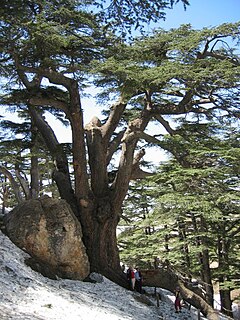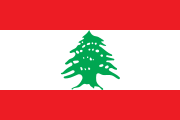| Lebanon Cedar | ||||||||||||||
|---|---|---|---|---|---|---|---|---|---|---|---|---|---|---|
 Lebanon Cedar in the Forest of the Cedars of God | ||||||||||||||
| Conservation status | ||||||||||||||
| Scientific classification | ||||||||||||||
| ||||||||||||||
| Binomial name | ||||||||||||||
| Cedrus libani A. Rich. |
Cedrus libani (Lebanon Cedar or Cedar of Lebanon), is a species of cedar native to the mountains of the Mediterranean region, in Lebanon, western Syria and south central Turkey, with varieties of it (some treated as separate species by some authors) in southwest Turkey, Cyprus, and the Atlas Mountains in Algeria and Morocco in northwest Africa.[1][2][3] The Cedars Conservancy parks in Lebanon were candidates in the New 7 Wonders of Nature competition but were eliminated at the end of the first stage while the Jeita Grotto was chosen as the Lebanese national candidate.[4]
Description
The Lebanon Cedar is an evergreen coniferous tree growing up to 40 m (130 ft) tall, with a trunk up to 2.5 m (8 ft 2 in) diameter. The crown is conic when young, becoming broadly tabular with age with more or less level branches. The shoots are dimorphic, with long shoots and short shoots. The leaves are needle-like, spaced out on the long shoots, and in clusters of 15-45 on the short shoots; they are 5-30 mm (1⁄4–1 3⁄16 in) in length, quadrangular in cross-section, and vary from green to glaucous blue-green with stomatal bands on all four sides. The seed cones are produced often every second year, and mature in 12 months from pollination; mature cones in late autumn are 8-12 cm (3–4 3⁄4 in) long and 4-6 cm (1 1⁄2–2 3⁄8 in) wide.
Taxonomy
There are four ill-defined varieties, treated as subspecies or closely related species by some authors:
- Cedrus libani var. libani (Lebanon Cedar): Lebanon, western Syria and south central Turkey
- Cedrus libani var. stenocoma (Turkish Cedar): southwest Turkey
- Cedrus libani var. brevifolia (Cyprus Cedar): Cyprus
- Cedrus libani var. atlantica (Atlas Cedar): Atlas Mountains
The treatment of the Turkish, Cyprus and Atlas Cedars as varieties or subspecies of Lebanon Cedar is found primarily in botanical and floristic works,[2][5][6][7][8][9][10][11][12] while treatment as separate species is more widespread in popular horticultural use,[13] but also in some botanical works.[1][14][15] The discrepancy in treatment derives largely from the very narrow gene base of trees in cultivation, which gives a false impression of distinctiveness of the taxa, not borne out when the wider range of variation found in wild trees is examined.[16]
Ecology
In Lebanon and Turkey it is most abundant at altitudes of 1,000-2,000 m (3,300–6,500 ft), where it forms pure forests or mixed forests with Cilician Fir (Abies cilicica), European Black Pine (Pinus nigra), and several juniper (Juniperus) species. In Cyprus, it occurs at 1,000-1,525 m (3,300–5,000 ft) (reaching the summit of Mount Paphos). In the Atlas Mountains, it occurs at 1,370–2,200 m (4,500–7,200 ft) in pure forests or mixed with Abies species and Juniperus thurifera.[1]
History, symbolism and uses
Cedar of Lebanon was important to various civilizations. The trees were used by the ancient Phoenicians for building trade and military ships, as well as houses and temples. The Egyptians used its resin for mummification, and its sawdust was found in pharaohs' tombs. The Sumerian Epic of Gilgamesh designates the cedar groves of Lebanon as the dwelling of the gods to where Gilgamesh ventured. They once burned cedar in their ceremonies. Jewish priests were ordered by Moses to use the bark of the Lebanon Cedar in circumcision and treatment of leprosy. Isaiah used the Lebanon Cedar as a metaphor for the pride of the world[17] According to the Talmud, Jews once burned Lebanese cedar wood on the Mount of Olives to announce the new year. Kings far and near requested the wood for religious and civil constructs, the most famous of which are King Solomon's Temple in Jerusalem and David's and Solomon's Palaces. It was also used by Romans, Greeks, Persians, Assyrians and Babylonians.[18]
Historically, extensive deforestation has occurred, with only small remnants of the original forests surviving. Deforestation has been particularly severe in the Lebanon and Cyprus; on Cyprus, only small trees up to 25 m (82 ft) tall survive, though Pliny the Elder recorded cedars 40 m (130 ft) tall there.[19] Extensive reforestation of cedar is carried out in the Mediterranean region, particularly Turkey, where over 50 million young cedars are being planted annually.[20] The Lebanese populations are also now expanding through a combination of replanting and protection of natural regeneration from browsing by goats.[21]
Regional significance
The Lebanon Cedar has always been the national emblem of Lebanon, and it is seen on the Lebanese Flag. It is also the main symbol of the Cedar Revolution, along with many political parties in Lebanon such as the Kataeb, the National Liberal Party and the Lebanese Forces.[22]
As a result of long exploitation, very few old trees remain in Lebanon, but there is now an active program to conserve and regenerate the forests. The forest of the Cedars of God in Bsharri and the Barouk forest are national reserves in Lebanon.[23][24][25] Extensive replanting is taking place in Turkey, where approximately 300 square kilometres (74,000 acres) of cedar are planted annually.[21]
Horticultural use
The Lebanon Cedar is widely planted as an ornamental tree in parks and large gardens, often being planted in avenues, and as focal point trees in large lawns.
Location
Map of the cedar's forests and the surrounding mountains (www.mount-lebanon.com)
Gallery
| Lebanon Cedar in Al Shouf Cedar Nature Reserve, Barouk, Lebanon | |||
| Small Lebanon Cedar in half barrel pot, Noda, Chiba Japan |










0 comments:
Post a Comment